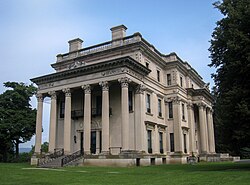Vanderbilt Mansion National Historic Site
|
Vanderbilt Mansion National Historic Site
|
|

Hyde Park, with classicism, balance, and ornamentation, is an example of Beaux-Arts architecture.
|
|
| Location | Hyde Park, New York |
|---|---|
| Coordinates | 41°47′46″N 73°56′31″W / 41.79611°N 73.94194°WCoordinates: 41°47′46″N 73°56′31″W / 41.79611°N 73.94194°W |
| Area | 211 acres (85 ha) |
| Built | 1896–99 |
| Architect | McKim, Mead & White |
| Architectural style | Beaux-Arts |
| Visitation | 372,517 (2005) |
| Website | Vanderbilt Mansion National Historic Site |
| NRHP Reference # | 66000059 |
| Significant dates | |
| Added to NRHP | October 15, 1966 |
| Designated HD | October 15, 1966 |
| Designated NHS | December 18, 1940 |
The Vanderbilt Mansion National Historic Site is a historic house museum in Hyde Park, New York. It became a National Historic Landmark and started operation under the National Park Service in 1940. The mansion, known as Hyde Park, was the Gilded Age home of Frederick William Vanderbilt and his family from 1895 to 1938.
The 54-room Vanderbilt mansion was designed by the architectural firm McKim, Mead & White. Designed and built between 1896 and 1899, the house is an example of the Beaux-Arts architecture style. The interior of the mansion is an archetype of the American Renaissance, incorporating European antiques and intricate period reproductions. The site includes 211 acres (85 ha) of the original larger property, including lawns against the Hudson River, formal gardens, woodlands, and auxiliary buildings. The grounds also include Italian gardens that were restored by the volunteer Frederick W. Vanderbilt Garden Association.
Known as Hyde Park, the Vanderbilt site is one of the area's oldest Hudson River estates. The earliest development of the estate began in 1764 when Dr. John Bard purchased land on the east side of the Albany Post Road, where he built Red House and developed the agricultural aspects of the eastern section of the property that continued through Frederick and Louise Vanderbilt's occupancy. Bard family ownership continued through 1821 with his son, Dr. Samuel Bard (1742–1821), owning the property from 1799 to 1821. In 1828, Dr. David Hosack, president of the New York Horticultural Society, purchased the property from Samuel Bard's heirs, with André Parmentier helping to design the grounds. In 1840, John Jacob Astor purchased the property from Hosack's heirs for his daughter Dorothea and her husband Walter S. Langdon.
...
Wikipedia


